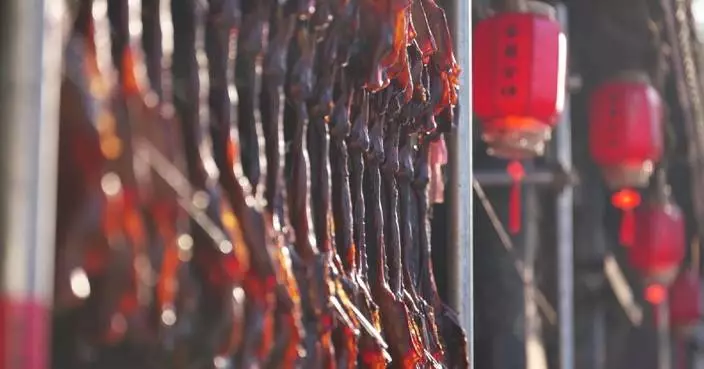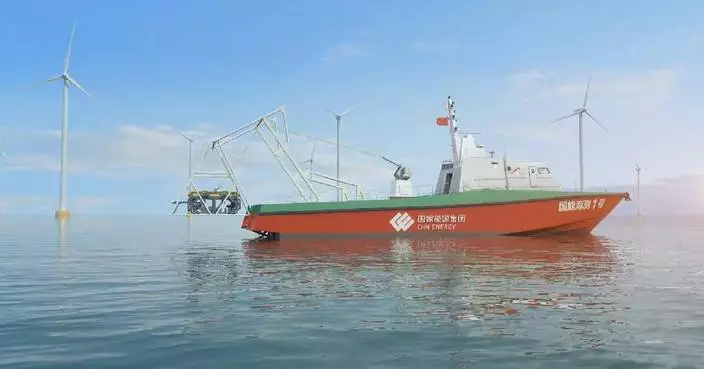SALT LAKE CITY (AP) — Defenseman Sean Durzi got a taste of the NHL in Salt Lake City when he and the Kings played the Golden Knights in a 2022 preseason game.
Durzi had a goal and two assists in Los Angeles' 6-4 loss to Vegas, but more than his play on the ice, what stuck with him was the fans' passion that night even though they didn't have a home team to cheer on.
That will soon change. Delta Center now is the home to the Utah Hockey Club, which opens its first training camp Thursday after 28 seasons in the Phoenix area as the Coyotes.
“You come here on the road in the ‘Frozen Fury,' you get a great atmosphere," Durzi said. "But to know this is our home now, this is where we're going to be playing in front of such passionate fans, it's special.”
The club had its first media day Wednesday, another step in the process of completing the move from Arizona. Because there could be another form of the Coyotes in the future, Utah is calling itself as much of an expansion team as a relocated franchise, so all the club records and statistics begin anew.
In practical terms, though, this is mostly Arizona's old club that even general manager Bill Armstrong refers to as “the fourth year of the rebuild.”
In addition to the players, the front office also made the move from the triple-digit-degree days in the Valley of the Sun to the snowcapped mountains overlooking Salt Lake City thanks to Wednesday's fresh powder dump. The Jazz staff is handling the business side, such as marketing and ticket sales, with about 90 people being brought onboard to assist in those efforts.
There is renewed hope that maybe the franchise is — at long last — trending in the right direction. The Coyotes made the playoffs just once in their final 12 seasons. Perhaps more egregious, they spent their final two years playing in Arizona State University's rink as management tried in vain to get a deal done for a new arena to keep the team in the state.
Then Jazz owners Ryan and Ashley Smith bought the club, moved it to Salt Lake and poured resources into making sure what the team lacked in Arizona it had in Utah. That included putting money into a top-level temporary practice facility rather than piecing one together until a permanent structure is completed in about a year.
Renovations were made to Delta Center with more planned later to improve all the sight lines and create a better overall fan experience. Capacity this season will be 11,131 with obstructed-view seats added for select games, and that baseline seating number will increase in future years.
“There's very clearly a buzz around our team, as there should be, and we're looking forward to jumping on that opportunity” forward Lawson Crouse said. “In the past in Arizona, a lot of things were up in the air with the arena situation. It's clear we now have a home, so we can move on from all those distractions and just go play hockey, and we're really looking forward to doing that.”
Forward Clayton Keller, who led the club in goals (33) assists (43) and points (78) last season, is the top returning player and at 26 is part of the young core that the club is building around. To supplement the players that have been homegrown through the draft, Utah also upgraded its defense by acquiring Mikhail Sergachev and John Marino within 10 minutes of each other at the NHL draft and later signing veteran Robert Bortuzzo.
Goalie Connor Ingram, who won the Bill Masterson Memorial Trophy for perseverance and sportsmanship last season, comes off a campaign in which he had a .907 save percentage with a 2.91 goals-against average.
Players and management speak in cautiously optimistic tones about what to expect this season, and Armstrong didn't shoot down the question whether Utah could be buyers at the trade deadline. After pointing out there's a lot of work to do between now and then, Armstrong added, "If that moment presents itself, we do have the assets to make things happen.”
Being in playoff contention would be quite an initial season for a franchise just entering the honeymoon phase with its new fan base.
Even before the club put season tickets up for sale, 34,000 deposits were placed. The team has sold just short of 4,500 season tickets that covers all 41 home games and another 8,000 half-season packages.
On a more anecdotal and personal level, there's the in-person feedback those on the team have received as they've started to become more involved in the community.
“The way we've been received by people, by people inside the organization of the Jazz, they show their excitement to all of us,” coach André Tourigny said. “From everybody, it's been really, really welcoming.”
AP NHL: https://apnews.com/hub/NHL

Utah Hockey Club's Clayton Keller speaks during NHL hockey media day Wednesday, Sept. 18, 2024, in Salt Lake City. (AP Photo/Rick Bowmer)

Utah Hockey Club general manager Bill Armstrong speaks during NHL hockey media day Wednesday, Sept. 18, 2024, in Salt Lake City. (AP Photo/Rick Bowmer)

Utah Hockey Club coach Andre Tourigny speaks during NHL hockey media day Wednesday, Sept. 18, 2024, in Salt Lake City. (AP Photo/Rick Bowmer)

Utah Hockey Club's Sean Durzi speaks during NHL hockey media day Wednesday, Sept. 18, 2024, in Salt Lake City. (AP Photo/Rick Bowmer)
Donald Trump began his first day as the 47th president of the United States with a dizzying display of force, signing a blizzard of executive orders that signaled his desire to remake American institutions while also pardoning nearly all of his supporters who rioted at the U.S. Capitol on Jan. 6, 2021.
Here's the latest:
Speaking to Fox News, press secretary Karoline Leavitt declined to detail the announcement before Trump spoke at 4 p.m. Tuesday but said it would also send a signal to the world.
“You won’t want to miss it,” she said. Trump is also scheduled to attend a national prayer service Tuesday morning at Washington National Cathedral.
House Speaker Mike Johnson and Senate Majority Leader John Thune are heading to the White House to meet with Trump on Tuesday.
It’s the first formal sit down for the GOP leadership teams including Majority Leader Steve Scalise and Senate GOP Whip John Barrasso and the new president as they chart priorities with the sweep of Republican power in Washington.
Despite an ambitious 100-days agenda, the Republican-led Congress isn’t on the same page on some of the basics of their ideas and strategies as they rush to deliver tax cuts for the wealthy, mass deportations and other priorities for Trump.
He pledged to remove more than 1,000 presidential appointees “who are not aligned with our vision.”
In a post on his TruthSocial platform, Trump dismissed chef and humanitarian Jose Andres from the President’s Council on Sports, Fitness and Nutrition, Ret. Gen. Mark Milley from the National Infrastructure Advisory Council, former State Dept. official Brian Hook from the board of the Wilson Center, and former Atlanta Mayor Keisha Lance Bottoms from the President’s Export Council.
“YOUR’E FIRED!” he wrote in a post just after midnight Tuesday.
Milley, the former chairman of the joint chiefs of staff under Trump, received a pardon from former President Joe Biden on Monday over concerns he could be criminally targeted by the new administration. His portrait in the Pentagon was also removed. Hook, who was Trump’s Iran envoy during his first term, had been involved in the Trump administration transition. No reasoning was given for his firing.
Former President Joe Biden also removed many Trump appointees in his first days in office, including former press secretary Sean Spicer from the board overseeing the U.S. Naval Acadamy.
Rep. Elise Stefanik is likely to face questions at her confirmation hearing Tuesday to become the U.S. ambassador to the United Nations about her lack of foreign policy experience, her strong support for Israel and her views on funding the U.N. and its many agencies.
Harvard-educated and the fourth-ranking member of the U.S. House, she was elected to Congress in 2015 as a moderate Republican and is leaving a decade later as one of President Trump’s most ardent allies.
U.N. Secretary-General Antonio Guterres “looks forward to working again with President Trump on his second term,” U.N. deputy spokesman Farhan Haq said Monday.
When she appears before the Senate Foreign Relations Committee, Stefanik is likely to be grilled about her views on the wars in Gaza, Ukraine, Sudan and elsewhere as well as the North Korean and Iranian nuclear programs — all issues on the U.N. agenda.
▶ Read more about Elise Stefanik’s confirmation hearing
Scholz said at the World Economic Forum in Davos on Tuesday that “not every press conference in Washington, not every tweet should send us straight into excited, existential debates. That’s also the case after the change of government that took place in Washington yesterday.”
Scholz said the U.S. is Germany’s closest ally outside Europe and he’ll do everything to keep in that way.
He acknowledged that Trump and his administration “will keep the world on tenterhooks in the coming years” in energy, climate, trade and security policy. But he said “we can and will deal with all this, without unnecessary agitation and outrage, but also without false ingratiation or telling people what they want to hear.”
Scholz said of Trump’s “America First” approach that there’s nothing wrong with looking to the interests of one’s own country – “we all do that. But it is also the case that cooperation and agreement with others are mostly also in one’s interest.”
Speaking in the Oval Office Monday, Trump rejected Biden’s warning that the U.S. is becoming an “ oligarchy ” for tech billionaires, saying the executives supported Democrats until they realized Biden “didn’t know what the hell he was talking about.”
“They did desert him,” Trump added. “They were all with him, every one of them, and now they are all with me.”
Despite taking millions from the executives and their companies for his inaugural committee — and receiving more than $200 million in assistance from Musk in his presidential campaign — Trump claimed he didn’t need their money and they wouldn’t be receiving anything in return.
“They’re not going to get anything from me,” Trump said. “I don’t need money, but I do want the nation to do well, and they’re smart people and they create a lot of jobs.”
Some of the most exclusive seats at Trump’s inauguration on Monday were reserved for powerful tech CEOs who also happen to be among the world’s richest men.
That’s a shift from tradition, especially for a president who has characterized himself as a champion of the working class. Seats so close to the president are usually reserved for the president’s family, past presidents and other honored guests.
The mega-rich have long had a prominent role in national politics, and several billionaires helped bankroll the campaign of Trump’s Democratic opponent, Vice President Kamala Harris.
But the inaugural display highlights the unusually direct role the world’s wealthiest people will likely have in the new administration. In his outgoing address, Biden warned that the U.S. was becoming an oligarchy of tech billionaires wielding dangerous levels of power and influence on the nation.
▶ Read more about the billionaires at Trump’s inauguration
Outside the National Cathedral, just a few hours before the Interfaith Service of Prayer for the Nation, which both President Trump and Vice President JD Vance are expected to attend, the scene before was decidedly quiet.
At the Cathedral only a few dog walkers dotted the sidewalk and the police presence was low.
It was a far cry from yesterday when thousands lined up in downtown D.C. festooned in the red regalia of MAGA nation — or the security and foot traffic from earlier this month for the funeral service of former President Jimmy Carter where Secret Service vehicles could be seen at least a mile from the Cathedral.
The Senate quickly confirmed Marco Rubio as secretary of state Monday, voting unanimously to give Trump the first member of his new Cabinet on Inauguration Day.
Rubio, the Republican senator from Florida, is among the least controversial of Trump’s nominees and vote was decisive, 99-0.
It’s often tradition for the Senate to convene immediately after the ceremonial pomp of the inauguration to begin putting the new president’s team in place, particularly the national security officials.
▶ Read more about Marco Rubio’s confirmation
All the living former presidents were there and the outgoing president amicably greeted his successor, who gave a speech about the country’s bright future and who left to the blare of a brass band.
At first glance, President Donald Trump’ssecond inauguration seemed like a continuation of the country’s nearly 250-year-long tradition of peaceful transfers of power, essential to its democracy. And there was much to celebrate: Trump won a free and fair election last fall, and his supporters hope he will be able to fix problems at the border, end the war in Ukraine and get inflation under control.
Still, on Monday, the warning signs were clear.
Due to frigid temperatures, Trump’s swearing-in was held in the Capitol Rotunda, where rioters seeking to keep him in power the last time roamed during the Jan. 6, 2021, attack. Trump walked into the space from the hall leading to the building’s west front tunnel, where some of the worst hand-to-hand combat between Trump supporters and police occurred that day.
After giving a speech pledging that “never again” would the government “persecute political opponents,” Trump then gave a second, impromptu address to a crowd of supporters. The president lamented that his inaugural address had been sanitized, said he would shortly pardon the Jan. 6 rioters and fumed at last-minute preemptive pardons issued by outgoing President Joe Biden to the members of the congressional committee that investigated the attack.
▶ Read more about Trump’s Inauguration Day

President Donald Trump signs an executive order to create the Department of Government Efficiency (DOGE) in the Oval Office of the White House, Monday, Jan. 20, 2025, in Washington, as White House staff secretary Will Scharf watches. (AP Photo/Evan Vucci)

President Donald Trump speaks as first lady Melania Trump listens at the Commander in Chief Ball, Monday, Jan. 20, 2025, in Washington. (AP Photo/Alex Brandon)

President Donald Trump signs an executive order on TikTok in the Oval Office of the White House, Monday, Jan. 20, 2025, in Washington. (AP Photo/Evan Vucci)


























































